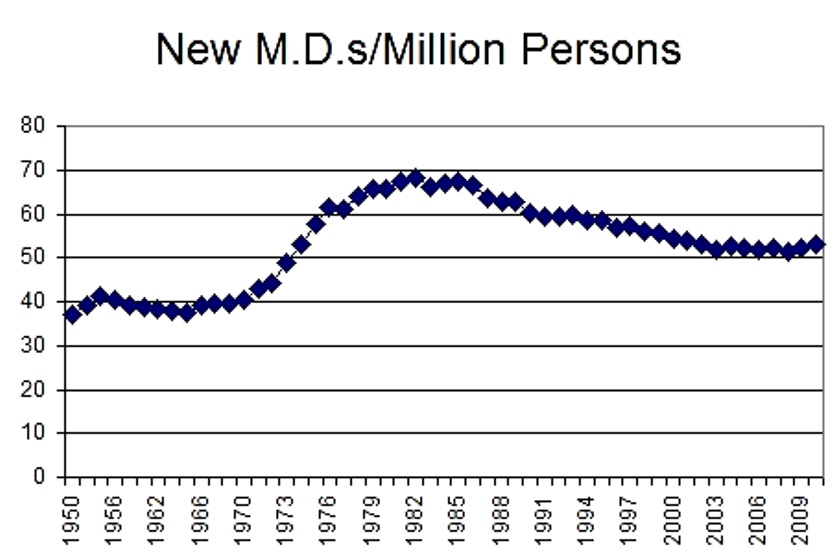Why Doctors are Becoming Scarcer
This is from Bryan Caplan. Full post is worth reading:
If you peruse this table, you’ll discover that total number of new M.D.s per year has been virtually flat for 30 years. During this period, population increased over 30%. As a result, the new M.D./population ratio has declined for decades.
If you’re not horrified, consider that the senior population ― doctors’ best customers ― increased by over 50%. As a result, new M.D.s per senior fell by about a third over the last three decades.



It seems misleading to exclude DO’s, since they have similar training to MD’s, and can enter the same residency programs. Are osteopaths filling the gap? Quite possibly. How effectively? That’s another question entirely.
I knew I should have become a doctor! I guess I’m still a little fuzzy on why we have a shortage. I understand there is a long lead time to train doctors. But eveyrone knows there is a shortage. And yet it seems we are not upping our output despite long lines to get into med school. I wonder what will happen when the demographic bulge coming down the pipes places its full burden on the health care system.
People make some remarkable assumptions about elasticity. Oh! More patients means more people will be doctors!
No.
The barriers are crazy, and it’s very inelastic.
Well at least with fewer doctors and longer wait times there will be more ER visits for the elderly, which are far more expensive.
There’s always that…
In Russia, our doctors are underpaid and struggle to get even basic supplies. Our hospitals are severely understaffed. We know the effects of having too few doctors. My advice to Americans: stay healthy and train more doctors. Russia is also suffering from an aging population in the post-Soviet era. Ours woes are not so different, America and Russia. Once enemies, now we both face the same health care challenges. In America, I enjoy the quality of health care. It would definitely be worse if I was home in Crimea.
Not to make this an immigration issue, but it seems the solution here may be to relax some visa restrictions on medical professionals. Just as American students disdain STEM majors but a tide of STEM workers exists ready to come here and work, the same may be true for medicine.
What incentives will get people to go to medical school? It seems as though high salaries aren’t doing it because doctors are typically relatively highly paid. Could it be that we need to look at reducing time-to-degree or looking at applied learning via apprenticeship programs to fill the gap?
This is very dissapointing. I’m not a big fan of the government offering incentives, but they could work. I also think if undergraduate biology courses were easier, you would see more people enter med school. Many very smart and qualified students are weeded out of the pre-med program due to poor Organic Chemistry and Biology scores from freshman year. As maqny people know, freshman year is a very shocking change from highschool and can trip up even the smartest kids.
There are ways to increase provider supply. But it involves allowing primary care to be provided by Nurse practitioners and the like.
I couldn’t tell if these charts were for the United States only or worldwide. If for the U.S. only, it’s maybe less of a big deal because India and other countries may create enough doctors for us to import if we run short.
I do think it’s worth considering the role that DO’s have in all of this. Since this is not considering DO’s who also become family doctors, among other specialties, how true is this graph after all?
I think this is an indication of how “unattainable” and getting a medical degree really is due to our broken education system and high cost of higher ed.
Mr. Sombers makes a valid point as does Cindy. What are we doing to address this problem?
The article that accompanys this chart just asserts that the government is the cause. Where is the evidence?
It’s also unclear whether this is even a problem. Perhaps someone knows of an article or study that quantifies in some way why it would be important to have an additional 20 Dr’s per million people?
Absent these two things, this chart is meaningless.
Taking a look at nurse rates would be interesting too. I have heard there is a shortage in Nursing, perhaps response to that shortage drove people out of Med School and into Nursing school? This would make sense, persons considering the one would likely consider the other and the shorter training period may be enticing. Just a thought.
Sorry I couldn’t resist being trolled.
Didn’t the pre-Soviet era result in the democide of like 50 million soviets. How are there any old people left?
Herald, really?? You think that we should make our science classes EASIER? So, if people have trouble passing the driving test, we should just make that easier too?
No, the problem is quotas. There are not enough scholarships or grants available to these potential med students.
This story makes no sense, because enrollment in medical schools increases every year.
This is from the Association of American Medical Colleges:
More than 45,000 students (45,266) applied to attend medical school in 2012, an increase of 3.1 percent. First-time applicants, considered to be a barometer of interest in medicine, set another record, increasing by 3.4 percent in 2012, for a total of 33,772 applicants. First-time enrollment at the nation’s medical schools grew 1.5 percent to 19,517 students, an all-time high.
At the current pace of enrollment gains, medical schools are on track to increase total enrollment 30 percent by 2016.
I assume that the reason for the stagnation is that doctors are specializing way more, and so, general physicians are not increasing in supply.